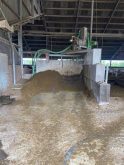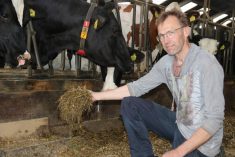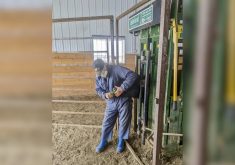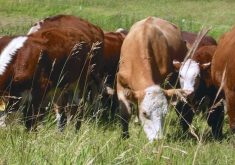Producers got a side-by-side comparison of different phosphorus treatments in alfalfa Aug. 30.
The phosphorus ramp, presented during the Manitoba Beef and Forage Initiatives (MBFI) Brookdale field tour, showcased consecutive strips of alfalfa grown with progressively more phosphorus. The ramp tracks crop impact in the three years following a one-time phosphorus application ranging from no fertilization to 100 pounds per acre.
“Basically, it’s a determination of what application rate of phosphorus is ideal for alfalfa in your environment,” presenter Ray Bittner of Manitoba Agriculture said. “Every environment is different with different moisture, different soil types.”
Read Also

Pig transport stress costs pork sector
Popular livestock trailer designs also increase pig stress during transportation, hitting at meat quality, animal welfare and farm profit, Agriculture and Agri-Food Canada researcher says
Two ramps were established in spring 2016 at the MBFI Brookdale site north of Brandon and in the Interlake. Final results are expected at the end of 2018.
Phosphorus is a farmer’s friend in the alfalfa field.
Higher phosphorus treatments showed progressively better yields in both locations, Bittner reported, although protein content showed little difference between high and low applications.
Bittner found that a 60-pound-per-acre treatment best balanced economic cost and yield benefit in the Interlake, although he stressed that the ideal treatment will depend heavily on what soil phosphorus levels are prior to the ramp-up.
“Both of them benefited from higher phosphorus levels in yield,” Bittner said. “Possibly more importantly, we noticed that the plant forage phosphorus levels were higher on higher application rates, so the plants knew that they were being more fertilized. They were actually putting more into the forage for phosphorus. It actually did make it into the system even though we did apply it in May and started harvesting in the end of June.”
Soil sat at roughly nine parts per million of phosphorus at Brookdale when plots were seeded in 2016. Bittner estimates that soil will need to reach 14 parts per million on the Olsen scale (a common measure that estimates available phosphorus) before the field will begin yielding fully.
While protein counts yielded little difference, the relationship between phosphorus and number of stems flipped over the two years. In 2016, researchers saw higher-phosphorus plots with fewer stems, while in 2017, the opposite was true.
“Take your alfalfa earlier,” Bittner advised. “Almost everybody is guilty of taking alfalfa too late and getting a high yield, but a low leaf yield in comparison to stems.”
Bittner also argued that any phosphorus application might be more effective in midsummer, directly after the first cut and timed to take advantage of the midsummer rains to move it into the soil.
Building up
The largely economic argument stemmed from years where phosphorus prices spiked, causing farmers to take a hit to their wallets if they wanted to fertilize.
In 2008, global fertilizer price skyrocketed, including phosphorus-based products.
According to a 2016 report by the University of Guelph, which tracked regional farm input prices over the last decade, some fertilizer prices jumped four to five times in the United States from 2007-08. At its peak, phosphorus-based fertilizer topped $1,000 or even $1,200 per tonne in both the U.S. and Canadian Great Lakes region, the report read.
At the same time, media reports in May 2008 stated phosphorus prices had more than doubled, from $608 to $1,364 per tonne, in the few months since December the previous year. By 2009, prices had fallen once again.
Bittner encouraged farmers to build soil phosphorus during low-cost years and limit expense during times when phosphorus cost is high.
Glenn Friesen, forage business development specialist with Manitoba Agriculture, said the phosphorus ramp might also impact best practices for stand longevity and weed competition, along with yield and forage quality.
“For us to showcase a phosphorus ramp in that part of the world — it’s new to that part of Manitoba. We haven’t done that kind of work before,” he said. “We know that fertility is very important in forages. It’s often thought of last in some areas and just based on the economics in the last while, it’s not on the forefront of a management priority for hay lands and so we thought that it would be valuable to have a demonstration on the farm to show that in those soil types, phosphorus fertility can play a very important role in your hay stand performance.”
Stand longevity is being studied through the phosphorus ramp, although current data is limited since both the Interlake and Brandon stands are young, Bittner said. More definite longevity data is expected by the end of the experiment.




















